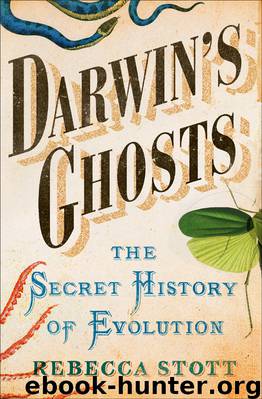Darwin's Ghosts by Rebecca Stott

Author:Rebecca Stott [Stott, Rebecca]
Language: eng
Format: epub
Tags: History, Biography, Non-Fiction, Science
ISBN: 9780679604136
Publisher: Spiegel & Grau
Published: 2012-01-01T00:00:00+00:00
By 1798, when he left for Egypt, Geoffroy Saint-Hilaire had been professor of vertebrates at the Jardin for five years. Like many serious young men who had been training for the priesthood, he had transferred his studies from theology to medicine after the Revolution. Discovering that he preferred mineralogy to medicine, he took lessons from a professor of mineralogy at the Collège of Navarre, René-Just Haüy, who was also a practicing Catholic priest. When Haüy was arrested and thrown into prison with several other priests during the street hunts of the Terror, Geoffroy, despite his revolutionary sympathies, disguised himself, borrowed a ladder, and tried to rescue his professor in the dead of night, resorting finally to alerting the professors at the Jardin, who secured his release. Terrified for his own safety, Geoffroy then fled Paris and returned to his parents’ home in the provinces, where he collapsed with a “nervous fever” that kept him in bed for months. There were rewards for such reckless loyalty. On his return to Paris, Haüy recommended his “young liberator” for a vacancy as a keeper in the Jardin’s cabinet and as assistant to the elderly professor of mineralogy Louis-Jean-Marie Daubenton. Eighteen months later, when the Jardin was transformed into the Museum of Natural History, Geoffroy found himself promoted to professor of zoology, a subject about which he knew very little.
After months spent arranging, assembling, identifying, and labeling hundreds of skeleton specimens in the new museum arriving from collections across Europe every day, Geoffroy was struck by the fact that so many of the animal skeletons he assembled—birds, lizards, apes, dolphins—seemed to be structured along the same architectural principles. He was twenty-four years old when he first articulated his big idea. “It seems that nature is confined within certain limits,” he wrote, “and has formed living beings with only one single plan, essentially the same in principle, but that she has produced variation in a thousand ways in all her accessory parts.”
In 1798, when Napoleon set sail to conquer Egypt in order to establish a base in the East and to disrupt British trade with India, Geoffroy volunteered to join the community of 167 of the most promising and prominent men in the French sciences whom Napoleon took with him to study Egypt’s history, culture, zoology, and landscape. Luck turned against the savants from the start. The ship carrying their equipment—scalpels, microscopes, tweezers, jars, pins—sank, and they had to wait for new supplies. Once Napoleon had taken Alexandria, the entourage of scientists followed the soldiers down the course of the Nile, where they had their first views of the pyramids, and into Cairo, where they requisitioned the harem quarters of a mansion recently built and then abandoned by a wealthy Mameluk and his retinue. French engineers, zoologists, archaeologists, and astronomers set up a study center there, holding meetings and reading papers in airy, marbled, and pillared rooms while Napoleon and his army of twenty-five thousand men fought for control of the country. In 1799, when
Download
This site does not store any files on its server. We only index and link to content provided by other sites. Please contact the content providers to delete copyright contents if any and email us, we'll remove relevant links or contents immediately.
| Fossils | Game Theory |
| Genetics | Molecular Biology |
| Organic | Paleontology |
Sapiens: A Brief History of Humankind by Yuval Noah Harari(13089)
Sapiens by Yuval Noah Harari(4561)
Homo Deus: A Brief History of Tomorrow by Yuval Noah Harari(4294)
Pale Blue Dot by Carl Sagan(4024)
Origin Story: A Big History of Everything by David Christian(3147)
Livewired by David Eagleman(3140)
Brief Answers to the Big Questions by Stephen Hawking(2886)
Inferior by Angela Saini(2843)
Origin Story by David Christian(2696)
The Evolution of Beauty by Richard O. Prum(2557)
Signature in the Cell: DNA and the Evidence for Intelligent Design by Stephen C. Meyer(2508)
The Gene: An Intimate History by Siddhartha Mukherjee(2502)
Aliens by Jim Al-Khalili(2389)
How The Mind Works by Steven Pinker(2229)
Sex at Dawn: The Prehistoric Origins of Modern Sexuality by Ryan Christopher(2153)
From Bacteria to Bach and Back by Daniel C. Dennett(2152)
A Short History of Nearly Everything by Bryson Bill(2144)
Endless Forms Most Beautiful by Sean B. Carroll(2092)
Who We Are and How We Got Here by David Reich(2066)
